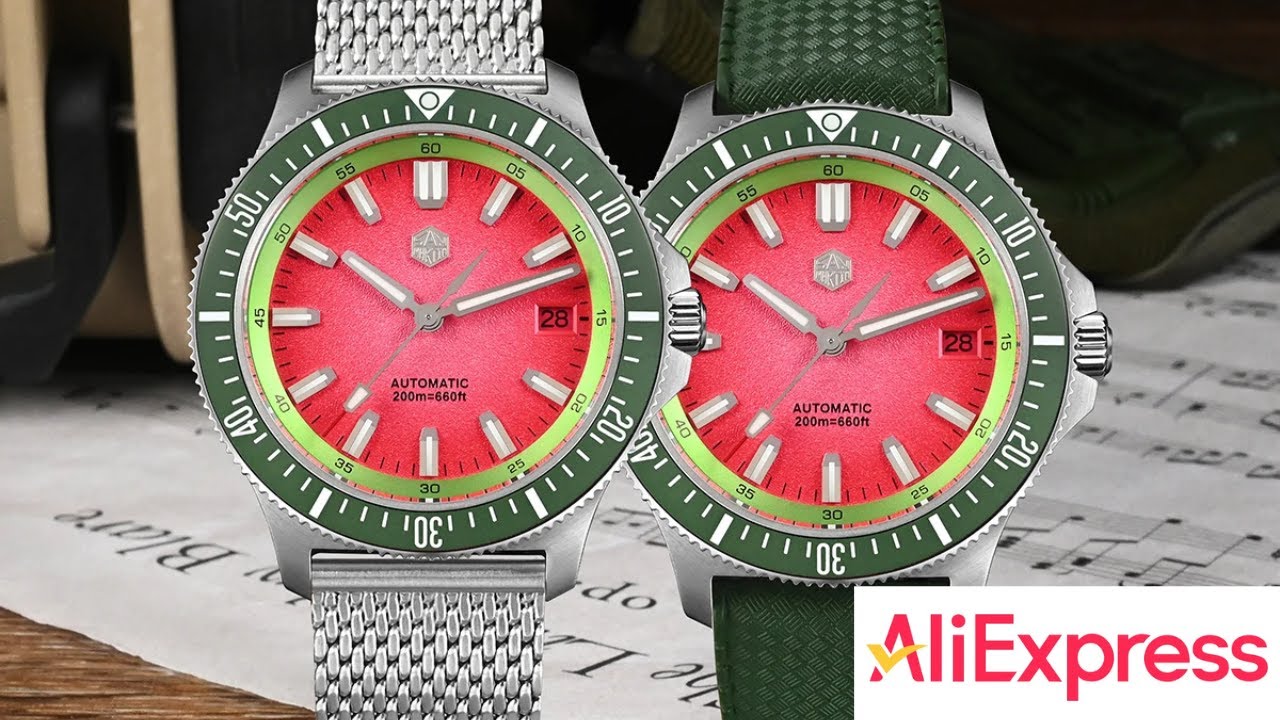How do Seiko and Sellita movements compare in San Martin Watch models?

When it comes to the world of horology, the debate between movements, particularly Seiko and Sellita, is a crucial one for watch enthusiasts and potential buyers alike. In recent years, San Martin has garnered attention for its meticulously crafted timepieces that incorporate these two prominent movements. This article will delve into a detailed comparison of Seiko and Sellita movements found in San Martin watch models, helping you make an informed decision as you explore your next watch purchase.
Understanding Movements: Seiko vs. Sellita
Before we dive into the specific applications in San Martin watches, it’s essential to understand what watch movements are. The movement, or caliber, is the mechanism that powers the watch and dictates its functions, including timekeeping accuracy, complications, and power reserve. Both Seiko and Sellita offer reliable movements, but they come with their distinct characteristics and appeal.
Seiko Movements
Seiko, a Japanese brand established in 1881, is renowned for its innovative approach to watchmaking. The brand produces a wide range of movements, from quartz to automatic calibers. Here are some key points regarding Seiko movements:
- Japanese Precision: Seiko movements are celebrated for their precision and reliability. This Japanese craftsmanship ensures that watches maintain accuracy even under varying conditions.
- In-House Production: Seiko manufactures its movements in-house, giving it control over quality and innovation.
- Diverse Range: Seiko offers a broad spectrum of movements, including the popular Caliber 4R35, widely recognized for its robustness and performance.
- Affordability: Seiko movements are often more affordable than their Swiss counterparts, making them a popular choice for budget-conscious consumers.
Sellita Movements
Founded in Switzerland in 1950, Sellita is known for manufacturing reliable movements that are often used by various Swiss watch brands. Let’s explore some of the defining features of Sellita movements:
- Swiss Heritage: Sellita movements carry the hallmark of Swiss craftsmanship, which is synonymous with precision and quality in the watchmaking industry.
- Compatibility: Sellita movements often serve as alternatives to ETA movements, providing similar specifications and functionality, making them highly compatible with many watch designs.
- Robustness: The movements are known for their durability and ability to withstand everyday wear and tear.
- Customization: Sellita offers a variety of movements that can be customized based on the specific needs of watchmakers, allowing for unique timepiece configurations.
San Martin Watches: The Connection
San Martin, a brand that has rapidly gained popularity in the microbrand segment, creatively blends traditional craftsmanship with modern technology. The brand has incorporated both Seiko and Sellita movements into its diverse lineup, leading to an interesting comparison that potential buyers should consider.
Seiko Movements in San Martin Watches
San Martin’s models equipped with Seiko movements primarily feature the Caliber NH35, which is an automatic movement based on the Seiko Caliber 4R35. Here’s why these movements are a popular choice in San Martin watches:
- Performance: The NH35 offers a power reserve of approximately 40 hours, providing reliability for daily wear.
- Hacking Feature: This movement includes a hacking functionality, allowing users to stop the second hand while setting the time for improved accuracy.
- Affordability: The inclusion of Seiko NH35 movements in San Martin watches helps keep prices competitive without compromising quality.
Sellita Movements in San Martin Watches
On the other hand, San Martin also utilizes Sellita movements, particularly the SW200, which is known for its Swiss engineering. Here’s a closer look at the benefits of these movements:
- High Quality: The SW200 movement is renowned for its craftsmanship and reliability, making it a go-to choice for many luxury Swiss brands.
- Accuracy: With a power reserve of around 38 to 40 hours, the SW200 ensures precise timekeeping.
- Service Availability: Sellita movements are widely recognized among watchmakers, making them easier to service compared to some lesser-known movements.
- Refinement: The SW200 is often considered more refined in operation compared to some Seiko movements, appealing to those who prioritize a smooth sweep of the second hand.
Key Comparisons Between Seiko and Sellita Movements in San Martin Watches
It’s crucial to consider various factors when comparing Seiko and Sellita movements in San Martin watches. Here are the primary differences:
Accuracy
Both Seiko and Sellita movements are designed to maintain excellent accuracy. However, slight variations may occur due to the specific movement model:
- Seiko NH35: Generally holds a timekeeping accuracy of around +20 to -20 seconds per day.
- Sellita SW200: Known for better precision, it typically delivers a range of ±10 to ±20 seconds per day, providing a slight edge in timekeeping reliability.
Maintenance and Serviceability
Maintenance is an essential factor for any watch owner. Here’s how the two fare:
- Seiko Movements: Easy to maintain and repair, but they may not be as widely recognized, potentially leading to limited service options in certain regions.
- Sellita Movements: Highly regarded by watchmakers, Sellita movements tend to be more universally serviced, making it easier for owners to find qualified professionals.
Cost
Price is often a decisive factor in choosing a watch. When comparing San Martin models featuring Seiko versus Sellita movements:
- Watches with Seiko NH35: tend to be more budget-friendly, appealing to those seeking a quality watch without a high price tag.
- Watches with Sellita SW200: may be priced slightly higher due to Swiss craftsmanship, specializing in luxury functionality and aesthetic.
Performance and Power Reserve
Power reserves are vital, especially for mechanical watches. Consider the following:
- Seiko NH35: boasts a power reserve of approximately 40 hours.
- Sellita SW200: similarly offers a power reserve of around 38 to 40 hours, ensuring reliable performance.
Design and Features
The design and additional features of the movements also play a crucial role:
- Seiko Movements: Often include features like the hacking and hand-winding capabilities.
- Sellita Movements: Provide smooth sweeping second hands, and additional features such as winding mechanisms based on the brand’s specifications.
Popular San Martin Models Featuring Seiko and Sellita Movements
To better understand the choices available, let’s look at a few popular San Martin models that feature either Seiko or Sellita movements.
San Martin Model with Seiko Movement
One notable model is the San Martin SN017. This dive watch highlights:
- Movement: Seiko NH35
- Case Material: 316L Stainless Steel
- Water Resistance: 300 meters, perfect for diving enthusiasts
- Design: Bold luminous markers and a unidirectional bezel
The combination of Seiko’s movement with San Martin’s design creates an attractive option for both diving and everyday wear.
San Martin Model with Sellita Movement
On the other side, the San Martin SKX007 model is favored by watch collectors for its quality and aesthetics:
- Movement: Sellita SW200
- Case Thickness: 14mm for a robust yet comfortable fit
- Dial: Vintage-inspired with a clean layout for easy reading
- The Water Resistance: 200 meters, suitable for various activities
This model stands out for its smooth movement operation, appealing to those who appreciate solid Swiss engineering.
Making Your Choice: Seiko or Sellita in San Martin Watches
Choosing between Seiko and Sellita movements really comes down to your personal preferences and practical needs. If you prioritize affordability and enjoy Japanese craftsmanship, the Seiko-powered models may be ideal for you. On the other hand, if you value Swiss quality and precision, the Sellita-driven creations could offer the features you seek.
When considering your next San Martin watch, think about factors such as style, budget, and the specific use case for the watch you’re interested in securing. Whether it’s for diving, casual wear, or professional settings, both movements offer distinct advantages.
Ultimately, San Martin’s commitment to creating quality timepieces is evident, with both Seiko and Sellita movements showcasing durability and performance. You can trust that no matter which movement you choose, you are making a valuable investment in a well-crafted watch.
Explore the collection of San Martin timepieces today to find the perfect blend of style and functionality that meets your needs.

When comparing Seiko and Sellita movements in San Martin watch models, it’s essential to highlight their distinct characteristics. Seiko movements, particularly the NH35, are known for their reliability and robustness, offering a great value for automatic watches. Conversely, Sellita movements, such as the SW200, are renowned for precision and craftsmanship, often found in mid-range Swiss watches. Each movement provides a unique appeal for watch enthusiasts, contributing to San Martin’s reputation for quality and affordability. With either movement, customers can expect durability, style, and performance that makes a San Martin watch a worthy addition to any collection.
FAQ
1. What are the main differences between Seiko and Sellita movements in San Martin watches?
The primary differences lie in their origin and engineering. Seiko movements, like the NH35, are Japanese and offer robustness, while Sellita movements, such as SW200, are Swiss and focus on precision. Users often prefer Seiko for casual wear and Sellita for more formal occasions.
2. Which movement is more reliable for everyday use?
Both Seiko and Sellita movements are reliable, but Seiko is often favored for daily wear because of its ruggedness. The NH35 is particularly appreciated for its resilience, making it an excellent choice for those with an active lifestyle.
3. How do the prices of San Martin watches with Seiko and Sellita movements compare?
Typically, San Martin watches with Sellita movements are priced slightly higher than those with Seiko due to the Swiss craftsmanship and precision associated with Sellita. However, both options represent exceptional value within their price ranges.
4. Can I find spare parts for Seiko and Sellita movements easily?
Yes, spare parts for both movements are readily available. Seiko parts can be sourced from authorized dealers, while Sellita parts are commonly found through various suppliers, making maintenance straightforward and accessible for watch enthusiasts.
5. Which movement is better for watch collecting?
It depends on personal preference. Seiko appeals to those who appreciate Japanese innovation and durability, while Sellita offers a taste of Swiss engineering. Collectors often appreciate the nuances of both movements, making them both valuable additions to any collection.
Conclusion
In summary, the choice between Seiko and Sellita movements in San Martin watches largely depends on personal preference and intended use. Whether you prioritize the ruggedness of Seiko or the precision of Sellita, both movements assure quality and craftsmanship that elevate your watch collection. Investing in a San Martin watch with either movement guarantees satisfaction, style, and durability, making it an excellent choice for any watch enthusiast.




